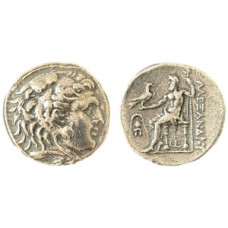Reproduction Alexander III (The Great) Tetradrachm
Obverse: Head of Herakles to right, wearing lion's skin headdress.
Reverse: Zeus seated left on low throne with high back, holding long sceptre in his left hand and, in his right, eagle standing right with closed wings. He is naked from the waist up, with a himation (linen or woollen cloak) covering his lap and legs. In the left field is a crested helmet, and below the throne the monogram ΘΕ. Text to the right ΑΛΕΞΑΝΔΡΟΥ "Of Alexander".
History: The tetradrachm was Alexander III of Macedon’s (The Great) silver stater, or standard denomination and was struck in very large quantities. The silver was mined from native mines in Macedonia and Thrace as well as from the huge stock of bullion that he captured from the Persians.
The images of the youthful Herakles / Hercules and enthroned Zeus that appear on this coin are the standard types used in the silver coinage of Alexander the Great during his lifetime. As a member of the ancient Macedonian royal family (the Argead dynasty) he claimed to be descended from Herakles, and Zeus, as king of the gods, so these were meaningful images for all Greeks, over whom Alexander aspired to rule.
The obverse of the tetradrachm coin depicts Herakles wearing a lion skin headdress, with the lion's gaping mouth covering the back of Herakles' head. This refers to his victory over the Nemian Lion in his First Labor. The reverse depicts Zeus holding a sceptre and eagle. The sceptre, being held in his left hand, is a symbol of his authority, whilst the eagle is one of Zeus' attributes, perches on his right hand.
The original of this coin was struck at Pella, the ancient city located in Central Macedonia, Greece, best known as the capital of the ancient kingdom of Macedon and birthplace of Alexander the Great.
Minted: Pella mint, circa 275-270 BC.
Diameter: 2.7cm
Tags: Alexander III, Alexander the Great, Silver, Tetradrachm, Herakles, Hercules, Zeus, Greek, Reproduction, Replica, Coin




